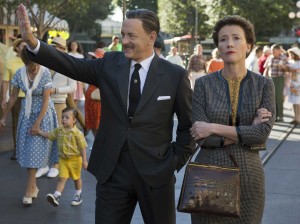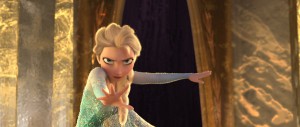
Anthony Lane’s review of Saving Mr. Banks reveals exactly how the film succeeds in captivating our attention:
“Sun came out to say hello to you!” Travers’s driver (Paul Giamatti) says, as she arrives in Los Angeles. “Don’t be preposterous,” she replies, and the movie is revived by that testiness and wit—the same qualities that rang through the fantastical briskness of the Poppins novels. Just as Mary rescued the wilting Banks family, so Thompson saves the film. A spoonful of her medicine makes the sugar go down
http://www.newyorker.com/arts/critics/cinema/2013/12/23/131223crci_cinema_lane
Beyond the collision of acerbic wit with a sunny disposition, there are powerful competing arguments in the film about what is “for your own good” when it comes to entertainments for children. “Where is the gravitas?” Travers asks a befuddled Walt Disney, who is committed to spiritual uplift with jaunty dialogue and upbeat tunes. After all, Mary Poppins, as the screenwriters imagine the book, was born of an adult’s need to work through childhood trauma. Walt and Pamela both suffered as children, with Walt bending to the will of an exploitative father who insists that his sons help out in the family business by delivering newspapers, no matter how cold it is or how long it takes, and Pamela witnessing an alcoholic father’s painful descent into dysfunction, illness, and death.
As adults, the two take different approaches to producing entertainments for children, and their views mirror the bifurcation of opinions in the field of children’s literature, with protectionists on one side and the “anything goes” folks on the other. Real life is fairly miserable, Rousseau lectured parents, and you might as well indulge the young. “Love childhood,” he wrote in his educational tract Emile, “promote its games, its pleasures, its amiable instinct.” That’s just what Walt Disney would say. Travers, by contrast, takes the view that we should not sugarcoat, that we should not play “let’s pretend” and instead teach children about the harsh realities of life. Mary Poppins does not exactly belong to the “hard facts” school of children’s literature, and Disney entertainments, as we know from all those crafty wicked figures dressed in purple and black (with a touch of gold), give us more than spoonfuls of sugar. But Saving Mr. Banks offers a great little tutorial on the high stakes in the game of writing for children, and it reminds us, in its title, as elsewhere in the film, that the redemption of adults might be the real holy grail sought by authors of children’s books.
And here’s Zoë Heller in the New York Times, January 4, 2013:
The new movie “Saving Mr. Banks” advertises itself as the story of how Walt Disney “worked his magic” to “bring Mary Poppins to life.” This tag line doesn’t just insult the author, P. L. Travers, who had already brought Mary Poppins to life very nicely, without Hollywood’s ministrations; it also does a disservice to Walt Disney’s boldness as an adapter. If there’s one thing Disney clearly did not attempt in the movie, it was to “capture” or portray the snappish, volatile, lower-middle-class nanny of the books. His infinitely more audacious decision was to kill off that Mary Poppins and replace her with another character altogether, a plummy-voiced, uncomplicatedly benign personage played by Julie Andrews.
We may feel that Travers’s Poppins is a more interesting and beguiling character than the one Disney invented — just as we may judge F. Scott Fitzgerald’s “Gatsby” to be a superior work of art to Luhrmann’s club remix. But this is only to say that Luhrmann’s and Disney’s genius was not equal to that of the authors from whom they borrowed. It does not follow that Luhrmann and Disney would have made better movies by being more respectful of the originals.
Most adaptations don’t achieve greatness (most films don’t, most art doesn’t), but those that do — Nicolas Roeg’s “Don’t Look Now,”Vittorio De Sica’s “The Garden of the Finzi-Continis,” Robert Hamer’s “Kind Hearts and Coronets,”Luchino Visconti’s “The Leopard,” most of Hitchcock’s oeuvre — are not distinguished by any unusual degree of loyalty to their original texts. Conversely, some of the dullest adaptations are the most slavishly “faithful.” (See Peter Jackson’s version of “The Hobbit,” a movie bogged down in C.G.I. and its director’s desperate determination not to offend Tolkien fans.) Given the choice between Jackson’s reverence and Disney’s chutzpah, I think I’d plump for the latter. At least “Mary Poppins” the movie gives us some good songs.


